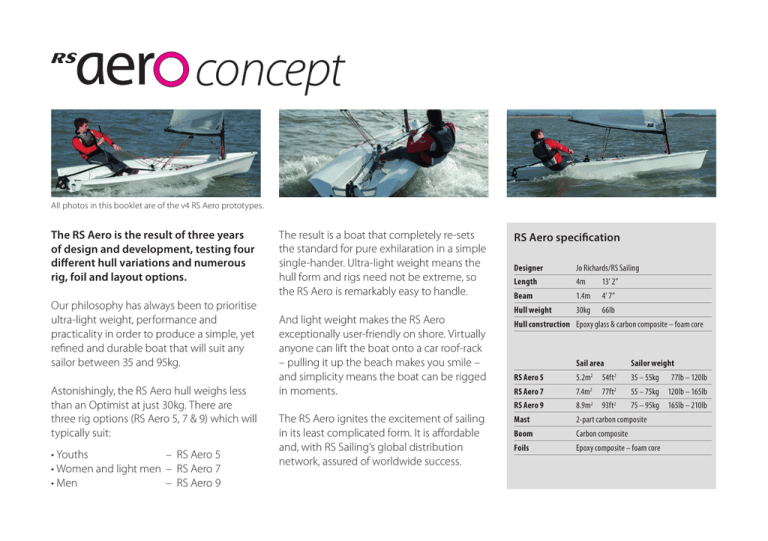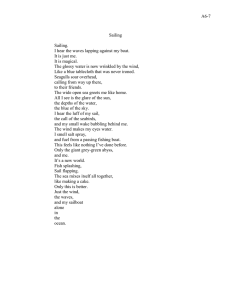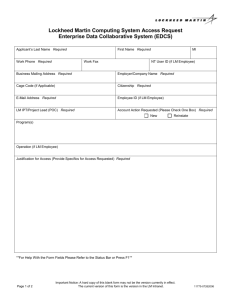concept - RS Sailing
advertisement

concept All photos in this booklet are of the v4 RS Aero prototypes. The RS Aero is the result of three years of design and development, testing four different hull variations and numerous rig, foil and layout options. Our philosophy has always been to prioritise ultra-light weight, performance and practicality in order to produce a simple, yet refined and durable boat that will suit any sailor between 35 and 95kg. Astonishingly, the RS Aero hull weighs less than an Optimist at just 30kg. There are three rig options (RS Aero 5, 7 & 9) which will typically suit: • Youths – RS Aero 5 • Women and light men – RS Aero 7 • Men – RS Aero 9 The result is a boat that completely re-sets the standard for pure exhilaration in a simple single-hander. Ultra-light weight means the hull form and rigs need not be extreme, so the RS Aero is remarkably easy to handle. And light weight makes the RS Aero exceptionally user-friendly on shore. Virtually anyone can lift the boat onto a car roof-rack – pulling it up the beach makes you smile – and simplicity means the boat can be rigged in moments. The RS Aero ignites the excitement of sailing in its least complicated form. It is affordable and, with RS Sailing’s global distribution network, assured of worldwide success. RS Aero specification Designer Jo Richards/RS Sailing Length 4m 13’ 2” Beam 1.4m 4’ 7” Hull weight 30kg66lb Hull construction Epoxy glass & carbon composite – foam core Sail area Sailor weight RS Aero 5 5.2m2 54ft2 35 – 55kg RS Aero 7 7.4m2 77ft2 55 – 75kg 120lb – 165lb RS Aero 9 8.9m2 93ft2 75 – 95kg 165lb – 210lb Mast 2-part carbon composite Boom Carbon composite Foils Epoxy composite – foam core 77lb – 120lb design notes hull We have found through testing that 4m length is sufficient to support the larger helmsman, without being too much of a handful for smaller sailors to launch and recover. An overall beam of 1.4m conveniently fits a normal roof-rack. Chine We have always felt that a chined hull is the correct approach, giving the sailor more reserve stability. The chine peels off the spray when sailing down wind and, at the same time, gives greater dynamic stability. The flatter panels of a chined hull allow construction from normal flat sheets of polyurethane (PU) foam, reducing the weight of the core bond (cores designed to mould around tighter curves “absorb” significantly more resin into their score cuts or honeycomb and are therefore heavier). by Jo Richards & RS Sailing against when trying to sit in if there is a wind lull or header. This is compensated by the flatter hull and increased form stability due to the buoyancy in the chine area The early prototypes had a higher chine, however through development, the chine has dropped to just below the water line amidships. This has proved to have several advantages: • A 35kg sailor gains the benefit of approximately the same waterline beam and hence the same hull form stability as a heavier sailor • The waterline beam and wetted surface does not change significantly with an increase in helm weight • We have found that because the RS Aero is so light there is less inertial mass to pull 2 • The chine has a small lip (or land) in order to reduce spray drag and for precise positioning of the computer cut PU foam panels during construction Fine bow The RS Aero has a fine bow for upwind sailing, stable mid-ship sections and a relatively wide transom. The transom shape has been fine tuned to ensure that the RS Aero planes bow up (analogous to the trim tabs on a powerboat stern). “...a feeling of security when sailing downwind in a blow...” Parallel gunwale As the RS Aero is relatively narrow, we have optimised the width by adopting the modern approach of running the gunwale parallel to the centreline in the aft half of the boat. This has a number of advantages: • Maximum righting moment wherever the helm sits out, irrespective of fore and aft position • When capsized the topside buoyancy is kept to a minimum, i.e. the boat floats lower in the water, allowing easier reach to the daggerboard (particularly important with a very light boat) • In plan view, the abrupt change of deck line at the front of the cockpit allows a fine bow without pushing out the overall width or the topsides forward, as would happen with a fair curve • Easier to sit alongside a RIB or the dock • More space to tie the mast sections alongside the boat on a roof-rack • The boat can be stored or transported more easily on its side The hull and deck are joined with a conventional gunwale. If there is no gunwale forward the boat is unnecessarily hard to launch and recover in waves – and is also very wet to sail upwind and tight reaching. Flat panel deck We have used, where possible, a chined flat panel deck to minimise weight and keep straight load-paths with structural corners. Numerous deck profiles were tested to maximise sitting out comfort whilst maintaining good “kick off” surfaces when roll tacking – and a feeling of security when sailing downwind in a blow. We have resisted the styling led temptation to cut away the deck at the transom – it is useful to sit on when bearing away in extreme conditions. 3 Mast step During construction, the mast step is located by a vertical pin, thereby ensuring mast rake and rig position are identical from boat to boat. After manufacture, the pin is removed to leave a drain hole for the mast tube. There is a stainless steel protector at the base of the mast tube to prevent wear. Stacking system The RS Aero is designed to stack – the hull above sits perfectly into the deck below. This allows three boats to be stacked on a conventional road trailer base with small carpettype pads between them – double and triple trailers are unnecessary. Efficient stacking allows over 30 boats to be loaded into a 40’ shipping container – minimising freight cost and carbon footprint in transport to dealers or regattas. “...carry it up the beach single handed...” construction Every aspect of the simple shape has been considered in order to minimise weight and maximise cost-efficient manufacture without compromising looks or performance: • Flatter panels on the chined hull allow construction from normal flat sheets of PU foam, reducing the weight of the core bond • “Chine” angles on the deck add form stiffness without additional weight • Low surface area reduces weight and material costs • Simple shape reduces time in the manufacturing process Epoxy resin is used for its high strength and low water absorption properties. Woven glass matt is used throughout the hull with carbon fibre in high load areas such as the hull and deck around the mast step, the hiking region of the deck, the gunwales and the transom. The tooling has been computer numerical control (CNC) machined to give maximum control over shape and symmetry. Due to its ultra-light weight and the high elongation at break (shatter resistance) of the 4 epoxy resin system, the RS Aero has proved to be remarkably durable. Yet the boat is so astonishingly light it is possible when landing to deliberately capsize the boat and to carry it up the beach single handed, by holding the toe-strap and the boom! Pulling the boat up the beach on a trolley makes you smile. Young sailors and small women can comfortably lift the RS Aero onto a roof-rack. “...the boat remains well balanced...” dynamic three rig system three rig system From day one we have assumed a requirement for three rigs of differing sail areas to cater for the desired crew weight range: RS Aero 5 – RS Aero 7 – RS Aero 9. three rig system We have developed rigs with sufficient control to totally flatten and twist the head of the sail upwind reducing the heeling moment. This allows a greater sail area to be carried – a big benefit downwind and in lighter conditions. Working closely with a world-leading carbon fibre tube manufacturer (the largest windsurfer mast and fishing rod manufacturer worldwide) we have produced the three rigs using a common top-mast and boom, yet radically differing stiffness bottom sections that are still compatible with the top-mast. The differing bend at deck level and stiffness of the three rigs ensure the boat remains well balanced, without resorting to a permanently pre-bent lower section for the smallest sail. The largest rig is 5.5kg lighter than the equivalent in aluminium alloy, and the cutting-edge production method offers very tight control on mast stiffness and weight. It is worth noting that even with the smallest RS Aero rig, the ratio of sail-area to hull-weight is significantly higher than most existing hiking single-handers, due to the incredibly light weight of the RS Aero hull. So, even the RS Aero 5 enjoys the amazingly responsive feel that makes the boat so exciting. The RS Aero rig is positioned well forward in the boat to provide a good distance between the mast and the centre-mainsheet to reduce sheet loads and for ease of gybing, without the risk of snagging associated with a transom led mainsheet. 5 The early prototype rigs had a sleeved luff mainsail – this proved impractical with the big headed mainsail, making it difficult to step the rig on windy days. There were also problems with the inboard end of the full length battens. Most sailors preferred the convenience of a main halyard on a tracked mast. “...a high level of user-friendliness...” sails This is the greatest area of conflict between styling pressures and the performance requirements of the RS Aero. It is not possible to produce a Mylar sail that will cope with the wide range of mast bend of a responsive carbon rig, in different wind strengths and on different points of sailing. This is due to the lack of bias (diagonal) stretch of the fabric. Mylar film is stable in all directions. We have, therefore, chosen a high denier Dacron sail fabric with a low filler content that offers good durability and a high level of user-friendliness. foils The RS Aero has a vertical daggerboard for ease of use. The daggerboard is of a glass/ carbon construction from CNC milled tooling, to a modern section developed successfully to reduce downwind drag whilst still generating enough lift upwind. The unusual profile is designed to fill the daggerboard slot in the hull until the point where the knuckle is reached – minimising drag. The tapered tip below the knuckle reduces tip losses. There is some evidence that a leading edge knuckle can provide greater stability of flow – it is not uncommon in birds! Evolved during testing, the rudder blade’s low drag section and surface area are extremely effective. We tested numerous rudder stocks and it became apparent that, due to the high 6 speed of the RS Aero downwind, none of the injection moulded rudder stocks provided enough stiffness. We have designed a custom, low pressure die cast, high grade alloy stock of minimalist size. The rudder blade can be rotated to vertical whilst ashore and is well supported at all angles whilst afloat. “...enabling the boat to be rigged in moments...” fit-out event programme Early prototypes had single-ended control systems for vang, cunningham and outhaul, cleated near the centreline for simplicity. However, the majority of test sailors wanted cleats on the side decks – we bowed to public demand. Whilst some RS Aeros will be purchased for the sheer enjoyment of sailing, the boat has already attracted many orders from racing sailors. The RS Aero is, for a wide range of sailors, the perfect club racing boat – quick to rig, light to launch, incredibly exhilarating. Fit-out is, nevertheless, simple whilst providing all the rig control needed and enabling the boat to be rigged in moments. As numbers grow, a range of RS Aero events will be created, with the programme incorporating entirely new event formats specifically for the RS Aero. Details to be released later. The centreline toe-strap is well padded for comfort, and adjustable to suit hiking style and sailor size. Functional and elegant custom designed carbon fibre RS Aero options include brackets for Tack Tick or Velocitek electronics, a GoPro camera mount and tiller extension. 7 design team Jo Richards Jo has the great advantage of being a top sailor as well as a highly experienced sailboat designer. Jo’s dinghy sailing career includes winning an Olympic medal in a Flying Dutchman that he designed, as well as several National 12 championship wins in his own designs. Jo also has a collection of big-boat classic wins to his name including the Fastnet Race. Not only do his designs include some of the world’s best selling volume production boats, but also a multiple Bol D’Or winning ‘Alinghi’ catamaran for Ernesto Bertarelli. Jo was also part of the design team for the ‘GBR Challenge’ America’s Cup campaign. Alex Newton-Southon – Technical Director, RS Sailing From the outset, RS boats have been created with passion. A passion to use the latest developments in construction and rig technology, to produce boats that are more exciting to sail, easier to handle and faster. Winners of multiple design awards around the world and accolades from top sailors everywhere, RS boats have become some of the most successful one-design classes of modern times – from club racing to widespread event programmes and World Championship level competition. RS Sailing Premier Way, Abbey Park Romsey, Hampshire SO51 9DQ United Kingdom © RS Sailing 2014. All rights reserved Tel. +44 (0)1794 526760 rssailing.com


